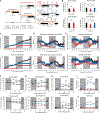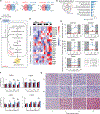Circadian clocks and periodic anticipated fasting prevent fasting-associated hepatic steatosis in calorie restriction
- PMID: 40802509
- PMCID: PMC12456247
- DOI: 10.1016/j.celrep.2025.116141
Circadian clocks and periodic anticipated fasting prevent fasting-associated hepatic steatosis in calorie restriction
Abstract
Calorie restriction (CR) improves health and longevity. CR induces a periodic fasting cycle in mammals; our study compares CR with unanticipated fasting (F), when the food is unexpectedly withheld. F induces hepatic steatosis, whereas CR reduces it; surprisingly, the difference is not due to hepatic β-oxidation. Liver transcriptome analysis identifies fatty acid transporters (Slc27a1 and Slc27a2), triglyceride (TAG) synthesis (Gpat4), and lipid storage (Plin2 and Cidec) genes to be upregulated only in F, in agreement with hepatic steatosis. The circadian clock and anticipated fasting contribute to preventing fasting-associated hepatic steatosis in CR. Mechanistically, the Slc27a1, Plin2, and Cidec genes are upregulated, and liver TAGs accumulate in circadian clock mutant mice on CR or if wild-type CR mice miss their anticipated meal. The results highlight the similarities and differences between F and CR, suggesting that circadian clock-dependent gating of transcriptional response to fasting controls lipid homeostasis and prevents hepatic steatosis.
Keywords: CP: Metabolism; Calorie restriction; circadian clock; circadian rhythms; dietary intervention; fasting; fatty acid metabolism; lipid metabolism; steatosis; triglyceride.
Copyright © 2025 The Authors. Published by Elsevier Inc. All rights reserved.
Conflict of interest statement
Declaration of interests The authors declare no competing interests.
Figures





References
-
- Zhang S, Ji B, Yang C, and Yang L (2023). Hepatic Lipid Homeostasis in NAFLD. In Non-alcoholic Fatty Liver Disease - New Insight and Glance into Disease Pathogenesis (IntechOpen; ).
-
- Haigh L, Kirk C, El Gendy K, Gallacher J, Errington L, Mathers JC, and Anstee QM (2022). The effectiveness and acceptability of Mediterranean diet and calorie restriction in non-alcoholic fatty liver disease (NAFLD): A systematic review and meta-analysis. Clin. Nutr. 41, 1913–1931. 10.1016/j.clnu.2022.06.037. - DOI - PubMed
MeSH terms
Grants and funding
LinkOut - more resources
Full Text Sources
Molecular Biology Databases
Research Materials
Miscellaneous

